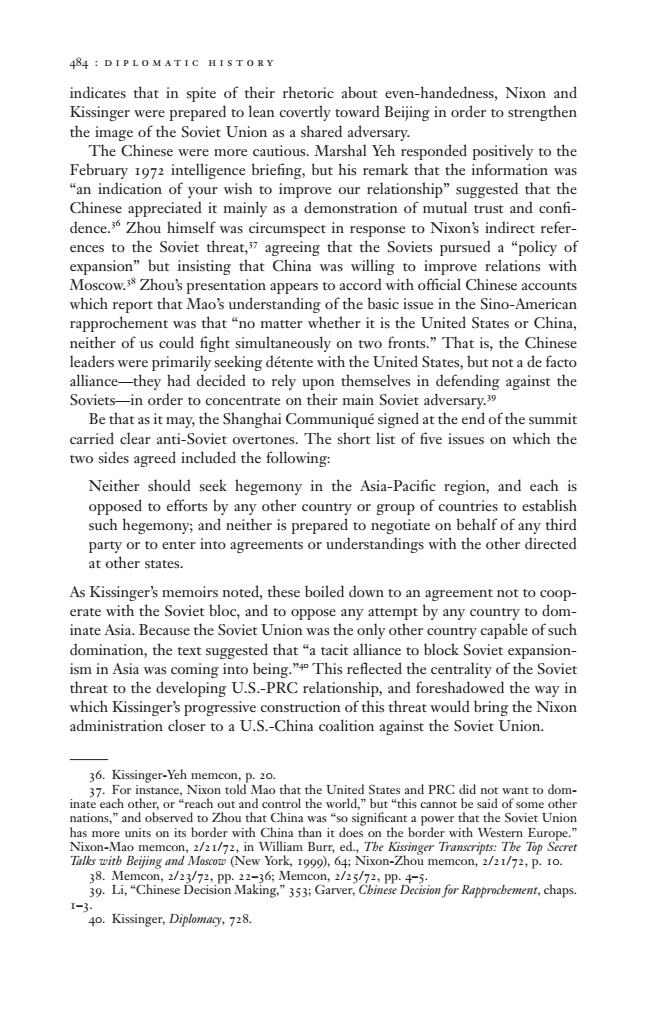正在加载图片...

484:DIPLOMATIC HISTORY indicates that in spite of their rhetoric about even-handedness,Nixon and Kissinger were prepared to lean covertly toward Beijing in order to strengthen the image of the Soviet Union as a shared adversary. The Chinese were more cautious.Marshal Yeh responded positively to the February 1972 intelligence briefing,but his remark that the information was "an indication of your wish to improve our relationship"suggested that the Chinese appreciated it mainly as a demonstration of mutual trust and confi- dence.s6 Zhou himself was circumspect in response to Nixon's indirect refer- ences to the Soviet threat,37 agreeing that the Soviets pursued a "policy of expansion"but insisting that China was willing to improve relations with Moscow.s Zhou's presentation appears to accord with official Chinese accounts which report that Mao's understanding of the basic issue in the Sino-American rapprochement was that "no matter whether it is the United States or China, neither of us could fight simultaneously on two fronts."That is,the Chinese leaders were primarily seeking detente with the United States,but not a de facto alliance-they had decided to rely upon themselves in defending against the Soviets-in order to concentrate on their main Soviet adversary.39 Be that as it may,the Shanghai Communique signed at the end of the summit carried clear anti-Soviet overtones.The short list of five issues on which the two sides agreed included the following: Neither should seek hegemony in the Asia-Pacific region,and each is opposed to efforts by any other country or group of countries to establish such hegemony;and neither is prepared to negotiate on behalf of any third party or to enter into agreements or understandings with the other directed at other states. As Kissinger's memoirs noted,these boiled down to an agreement not to coop- erate with the Soviet bloc,and to oppose any attempt by any country to dom- inate Asia.Because the Soviet Union was the only other country capable of such domination,the text suggested that "a tacit alliance to block Soviet expansion- ism in Asia was coming into being."4 This reflected the centrality of the Soviet threat to the developing U.S.-PRC relationship,and foreshadowed the way in which Kissinger's progressive construction of this threat would bring the Nixon administration closer to a U.S.-China coalition against the Soviet Union. 36.Kissinger-Yeh memcon,p.20. 37.For instance,Nixon told Mao that the United States and PRC did not want to dom- inate each other,or "reach out and control the world,"but "this cannot be said of some other nations,"and observed to Zhou that China was "so significant a power that the Soviet Union has more units on its border with China than it does on the border with Western Europe." Nixon-Mao memcon,2/21/72,in William Burr,ed.,The Kissinger Transcripts:The Top Secret Talks with Beijing and Moscow (New York,1999),64;Nixon-Zhou memcon,2/21/72,p.Io. 38.Memcon,2/23/72,Pp.22-36;Memcon,2/25/72,pp.45 39.Li,"Chinese Decision Making,"353;Garver,Cbinese Decision for Rapprocbement,chaps. I-3. 40.Kissinger,Diplomacy,728.indicates that in spite of their rhetoric about even-handedness, Nixon and Kissinger were prepared to lean covertly toward Beijing in order to strengthen the image of the Soviet Union as a shared adversary. The Chinese were more cautious. Marshal Yeh responded positively to the February 1972 intelligence briefing, but his remark that the information was “an indication of your wish to improve our relationship” suggested that the Chinese appreciated it mainly as a demonstration of mutual trust and confi- dence.36 Zhou himself was circumspect in response to Nixon’s indirect references to the Soviet threat,37 agreeing that the Soviets pursued a “policy of expansion” but insisting that China was willing to improve relations with Moscow.38 Zhou’s presentation appears to accord with official Chinese accounts which report that Mao’s understanding of the basic issue in the Sino-American rapprochement was that “no matter whether it is the United States or China, neither of us could fight simultaneously on two fronts.” That is, the Chinese leaders were primarily seeking détente with the United States, but not a de facto alliance—they had decided to rely upon themselves in defending against the Soviets—in order to concentrate on their main Soviet adversary.39 Be that as it may, the Shanghai Communiqué signed at the end of the summit carried clear anti-Soviet overtones. The short list of five issues on which the two sides agreed included the following: Neither should seek hegemony in the Asia-Pacific region, and each is opposed to efforts by any other country or group of countries to establish such hegemony; and neither is prepared to negotiate on behalf of any third party or to enter into agreements or understandings with the other directed at other states. As Kissinger’s memoirs noted, these boiled down to an agreement not to cooperate with the Soviet bloc, and to oppose any attempt by any country to dominate Asia. Because the Soviet Union was the only other country capable of such domination, the text suggested that “a tacit alliance to block Soviet expansionism in Asia was coming into being.”40 This reflected the centrality of the Soviet threat to the developing U.S.-PRC relationship, and foreshadowed the way in which Kissinger’s progressive construction of this threat would bring the Nixon administration closer to a U.S.-China coalition against the Soviet Union. 484 : diplomatic history 36. Kissinger-Yeh memcon, p. 20. 37. For instance, Nixon told Mao that the United States and PRC did not want to dominate each other, or “reach out and control the world,” but “this cannot be said of some other nations,” and observed to Zhou that China was “so significant a power that the Soviet Union has more units on its border with China than it does on the border with Western Europe.” Nixon-Mao memcon, 2/21/72, in William Burr, ed., The Kissinger Transcripts: The Top Secret Talks with Beijing and Moscow (New York, 1999), 64; Nixon-Zhou memcon, 2/21/72, p. 10. 38. Memcon, 2/23/72, pp. 22–36; Memcon, 2/25/72, pp. 4–5. 39. Li, “Chinese Decision Making,” 353; Garver, Chinese Decision for Rapprochement, chaps. 1–3. 40. Kissinger, Diplomacy, 728